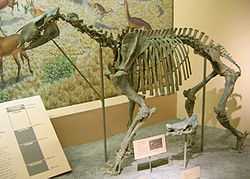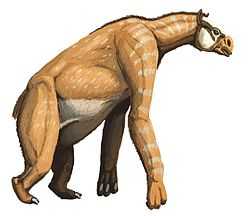Chalicothere
| Chalicotheriidae Temporal range: middle Eocene to late Pliocene 40–3.5Ma | |
|---|---|
 | |
| Moropus elatus at the National Museum of Natural History, Washington, DC | |
| Scientific classification | |
| Kingdom: | Animalia |
| Phylum: | Chordata |
| Class: | Mammalia |
| Order: | Perissodactyla |
| Family: | †Chalicotheriidae Gill, 1872 |
| Subfamilies and Genera[1] | |
| |
Chalicotheres (from Greek chalix, "gravel" + therion, "beast") were a group of herbivorous, odd-toed ungulate (perissodactyl) mammals spread throughout North America, Europe, Asia, and Africa during the Early Eocene to Late Pliocene subepochs living from 55.8 mya—3.5 million years ago, existing for approximately 55.02 million years.[2]
They evolved around 40 million years ago from small, forest animals similar to the early horses. Many chalicotheres, including such animals as Moropus and Chalicotherium, reached the size of a horse. By the late Oligocene, they had divided into two groups: one that grazed in open areas and another that was more adapted to woodlands. They died out around 3.5 million years ago. They are related to the extinct brontotheres, as well as to modern day horses, rhinoceroses, and tapirs.[3]

Description
Unlike modern perissodactyls, chalicotheres had long forelimbs and short hind limbs. Consequently, chalicotheres probably moved with most of their weight on their short, strong hind legs. Their front legs had long, curved claws indicating they knuckle-walked like giant anteaters today. Fossil remains have shown thick, developed front knuckles, much like gorillas. It was once thought that the claws were used to dig up roots and tubers, but the wear on the claws and teeth do not suggest that they dug or ate dirt-rich foods such as tubers. The chalicotheres probably used their claws to strip vegetation from trees and to forage for food.
Chalicotheres did not have front teeth in their upper jaw, and their back teeth show little wear, suggesting that they probably were selective browsers.[4]
Cryptozoology
Some cryptozoologists have hypothesised that the (supposedly carnivorous) cryptid from Africa, the Nandi Bear, could be a chalicothere.[5]
See also
References
- ↑ Coombs, Margery C. (13 February 2009). "The chalicothere Metaschizotherium bavaricum (Perissodactyla, Chalicotheriidae, Schizotheriinae) from the Miocene (MN5) Lagerstatte of Sandelzhausen (Germany): description, comparison, and paleoecological significance". Paläontologische Zeitschrift (Springer Berlin / Heidelberg) 83 (1): 85–129. doi:10.1007/s12542-009-0004-x. Retrieved 2009-12-29.
- ↑ PaleoBiology Database: Chalicotheres, basic info
- ↑ Savage, RJG, & Long, MR (1986). Mammal Evolution: an illustrated guide. New York: Facts on File. pp. 198–199. ISBN 0-8160-1194-X.
- ↑ Palmer, D., ed. (1999). The Marshall Illustrated Encyclopedia of Dinosaurs and Prehistoric Animals. London: Marshall Editions. p. 260. ISBN 1-84028-152-9.
- ↑ The Nandi Bear: Ferocious killer from the past on cryptozoology.com
- Paleobiology Database retrieved on November 23, 2007.